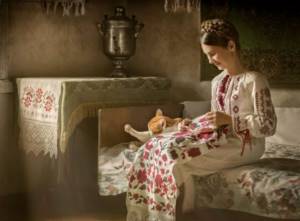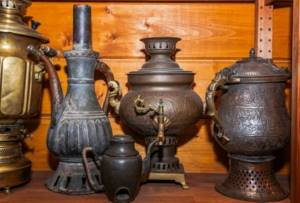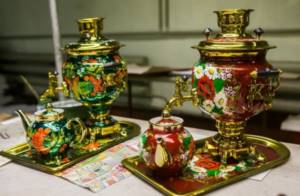Weddings
- What is included in the dowry?
- Dowry many years ago
- Dowry today
After the marriage proposal and the bride’s positive response, active preparations for the upcoming event begin. Of course, lovers usually have no time for everyday nuances. They are passionate about each other and their feelings about the upcoming change in life. But parents, wise with life experience, know that usually their children do not attach importance to household items and necessary equipment that surround them in their father’s house.
So that a young family does not need basic household items, there must be a dowry. It is collected by the bride's parents. It is not necessary to prepare a rich dowry - a minimal set is enough to help the young housewife arrange her life .
What is a bride's dowry?
Initially, the dowry was introduced to attract the attention of potential suitors. That is, this is the girl’s marriageable property, which she can provide to her future husband. After all, from the moment of marriage, all responsibilities of parents over their daughter pass to the spouse.
The bride's dowry means everything that the betrothed will bring, “add” or “add” to her man’s house for everyday life. The first mention of this custom came to us from the Middle Ages. Traditionally, the whole family was involved in preparing a whole chest of things from the very birth of the girl, mostly the mother and the bride herself.
Enviable and rich grooms from all over the area paid attention, first of all, to ladies who could interest them with a significant dowry. It is noteworthy that brides from poor families often remained without a dowry, which is why the chances of getting married successfully (or even getting married at all) were equal to zero.
A girl’s wedding “baggage” according to ancient traditions
Why did it become necessary to prepare the bride's trousseau? Because in ancient times, a girl was always in a dependent position. At first she depended on her family, in particular on the head of the family, who was the breadwinner, and then she got married and depended on her husband. Therefore, when entering a new family, she had to contribute to its capital. And in return, the husband was already obliged to care for and support his wife for the rest of his life.
If the bride did not have a dowry due to the poverty of her family, then it was very difficult for her to get married. Although there have been cases in history when “dowryless women” were chosen as wives out of great love. But in almost all cases in such a situation, the groom’s family disowned him and left him without support, so few people decided to take such a step. This is why the bride's dowry was so important.
Obviously, girls from a rich family had a better chance of finding a worthy life partner. But there was also a condition that equalized the position of brides of different incomes. Girls had to weave and embroider many things included in the dowry, for example, towels, themselves. And the more skillful the bride was in these matters, the more profitable she was considered. The most offensive and discreditable reputation of the young girl at that time was the nickname “netkachikha”.

What was included in the dowry of the ancient Slavs?
In the old days, girls prepared to manage the household and organize life in their husband’s house from childhood. Parents, to the extent of the family's well-being, provided the bride with fabrics, jewelry, and sometimes furniture and dishes. A lot fell on the girl’s shoulders; she weaved, sewed and embroidered to prepare for the most exciting moment of her life:
- feather beds;
- pillows;
- pillowcases;
- blankets;
- veils, curtains and curtains;
- towels
The bride had to sew all these elements herself, which would prove to her chosen one that the girl was not afraid of work and would be able to arrange life in the newlyweds’ new home. In the case when manual work was done by other people or was not done at all, the young lady was called an offensive word at that time - “netkakha”.
The girl’s personal belongings are also considered important, which will allow her husband not to worry about her well-being. The wedding dress itself, weekend clothes, sleeping shirts – all this also needs to be prepared by the bride’s family.

Renewal of forgotten traditions
The custom of preparing a girl’s dowry exists in many world cultures, including Ancient Rus' and modern Russia. The volume and quality of the dowry depended on the well-being of the family, but even poor people always had a minimum of things. The set included wedding decorations (dress and jewelry), bedding, and dishes. Without a dowry, a girl's chance of getting married was significantly reduced.
The preparation of the contents of the chest began from childhood. The bride and mother created towels, tabletops, shirts, and pillows with their own hands. These accessories were decorated with embroidery in the form of various patterns in accordance with the ethnic symbols characteristic of a particular region. The dowry was necessarily made with one’s own hands. Not a single girl was exempt from work, regardless of social status - the daughters of peasants, boyars and princes sewed.
When the dowry had to be transported, a special list was compiled and kept in the parental home or with the matchmaker. According to this list, the groom had to redeem the dowry - this guaranteed that things would be preserved under any circumstances. The future husband automatically transferred his status to the girl; in addition, the groom owned a plot of land.
Modern trousseau for the bride
Today, the bride's dowry is gradually losing its position among wedding traditions. If initially a whole list of things served as proof that the girl would not become a simple freeloader in a new family, then modern newlyweds, as a rule, earn money and manage the family budget together.
That is, the meaning of this tradition has been lost, although many weddings are still held, including the bride's dowry and its ransom. To do this, you no longer need to embroider household items all the time. As a rule, the bride's dowry is a monetary equivalent, with which the young family can take everything they need.
Although the view on the ancient Russian custom has changed, the list of necessary items will always be relevant. You can still arrange your life only with high-quality linen, kitchen utensils and practical appliances. That is, all sorts of things that are most often absent from a bachelor’s home will come in handy.
Bed sheets
Newlyweds in the first years of their life together will definitely be burdened with everyday work. It is important to make the bedroom a place where husband and wife can really relax; for this, the following will be useful:
- pillows;
- sets of linen (pillowcases, duvet covers, sheets);
- blankets;
- bedspreads;
Color solutions and materials do not play a special role, but the main thing is that they are soothing after a busy day; for this, neutral tones and natural materials are often chosen.
Underwear
Girls provide themselves with underwear that will please not only herself, but also her husband. Lace, stockings with belts and charming robes will only add more charm and sexuality to the girl’s natural beauty.
Bath towels
Here you should select several pairs of towels (preferably about 3) in different colors. This is required in order to ensure the comfort of bathing procedures for the husband and wife, and also to add a guest set. In addition to bath towels, small kitchen towels are also purchased.

Crockery and kitchen utensils
The kitchen is the wife’s abode. At the wedding, it is customary to give the bride a frying pan as a sign of her future control in the kitchen in her new home. However, in addition to this, you need to provide the kitchen and other kitchen utensils:
- pots (of different sizes);
- teapot;
- frying pans (depending on diameter);
- baking forms.
Dinnerware
A practical solution would be to buy a set of tableware for at least 4 people. Cutlery, deep and flat plates, cups - all this is always required in the family. Particular attention should be paid to glassware, as it breaks easily and requires care.
Appliances
Any household appliance can serve as a dowry. The spectrum is limited only by the financial ability of the bride’s family and what is available in the future husband’s house. As a rule, a washing machine, TV, and refrigerator serve as a significant dowry. A lower rank is considered to be a multicooker, food processor, etc.
Today, the success of a marriage is not determined by the size of the bride's dowry. Modern trends have changed from the old views on life, the role of women has changed, marriage now means something different than before.
Equal relationships, true love and mutual respect are much higher than material wealth. Preparing the bride's dowry has become nothing more than a tribute to tradition, which will help to avoid discomfort when starting a new life for the newlyweds.
List of must-have wedding luggage items
So, what was necessarily included in the bride's dowry? Everything that was required to set up a young family at first:
- pillows and blankets,
- towels,
- carpets and bedspreads,
- frying pans, pots, ladles and other kitchen utensils,
- cups, plates, forks and spoons.
In addition, the list of dowry that was prepared for the bride included clothes: two sets each for winter and summer for her, as well as several shirts, necessarily hand-embroidered for her future husband. Well, if the family’s wealth allowed, then jewelry and money. There were even special dowry shows, when matchmakers came to see what the potential bride had collected for her wedding day. And only then did they decide whether she was a suitable match for the groom.

All dowries were kept in chests. In a rich family they could occupy an entire room. As a rule, new chests were made for each future bride. And sometimes they themselves were of considerable value, since they could be made of valuable wood, gilded or decorated with precious stones.

Home decoration
Towels, flies, and tabletops, which were made by the bride, were used to decorate the house. Lace was woven, napkins, towels, paintings and other handicrafts were embroidered. Bed linen, tablecloths, curtains and bedspreads were also held in high esteem. The girl had to come to her husband’s house and completely renovate it with her creations. Their number spoke not only about the bride’s wealth, but also about her hard work.
The Troika transport card may be introduced in the regions as early as this year
Rare natural phenomenon discovered in Irish forest: hair ice
Will he run away from you? Types of women that turn guys off
Symbolic dowry: making a list
So, if your goal is to add a beautiful tradition to your wedding preparations, as well as to show yourself as a thrifty bride, you can limit yourself to the most standard set:
- set of bed linen – 1 piece;
- bath towels – 2 pcs.;
- table napkins (made of fabric) – 4 pcs.;
- cutlery set;
- tea-set;
- set of glasses;
- pots, pans – 2-3 pcs.;
- tablecloth.
That's all the belongings with which you can win the approval of traditionally minded relatives on your husband's side and avoid reproaches of lack of dowry in the distant future
On the other hand, please note that even such a modest set can cost a month’s salary - after all, everything must be new, unused! It may make sense to collect everything gradually, but keep in mind that previously used items are in bad taste and can only be forgiven in the poorest families.
It may make sense to collect everything gradually, but keep in mind that previously used items are in bad taste and can only be forgiven in the poorest families.
Full dowry wedding

Still, household items can also be very valuable, especially if there are a lot of them. Among the ancient Slavs, the dowry of a rich wife was not so much in lands and gold, but in fabrics, utensils and needlework, which she herself made for the wedding. And the more there was, the more attractive the bride became in the eyes of the groom’s family.
Previously, an auction was held for the dowry - a special day when the groom's relatives came to the bride. They were met in a spacious room, where all the goods prepared for the wedding were laid out in open chests.
And the parents of both parties agreed on the wedding ceremony, already based on this kind of bargaining - from whom how many valuables would go to the new family, and a kind of auction played an important role in this.
If you do not belong to the elite class of society, “bride wealth” can be collected according to the extended list above. So what's good for a bride?
An example of a “big list” of a bride’s dowry
- For yourself: the best lingerie, clothes for home and bedroom (robes, negligees), evening dresses, wedding dresses, jewelry;
- For the bedroom: bedding, towels, bedspreads, blankets, pillows, mattress;
- For the home: furniture and capes, curtains, carpets, tablecloths, vases, crystal;
- For the kitchen: festive dishes and for every day, cutlery, a set of pots and pans, kitchen utensils, glasses, glasses;
- Household appliances and electronics: washing machine, food processor, multicooker, scales, meat grinder, coffee maker, etc., computer, laptop, TV, refrigerator…
As you can see, such a list is far superior in value to the one we presented as symbolic. As a wife, you will make a huge contribution to the family hearth by bringing such belongings into the house
Please note that the equipment may not be new, unlike other items - utensils and textiles
How to collect a dowry for a wedding
- When getting ready to marry, collect your dowry according to plan - first the essentials, then expand the list as far as possible. Remember that you will be the first to use all this, especially when it comes to household supplies and items that create comfort at home.
- Choose everything of the highest quality, discreet style (linen - snow-white, towels - only terry, high-quality dishes), but don’t go after the high cost. Your young husband should not have the feeling that you have “overwhelmed” him with your things - let your dowry speak of modesty and care, and not of a desire to boast of wealth.
- For now, don’t use what you bought for your wedding. Everything that we have listed does not spoil - it will wait its time and give you and your spouse many moments of joy and a feeling of comfort.
Used items carry the charge of the family and life in which they were used. New things bring freshness and a sense of well-being into the home and into the hearts of the newlyweds - such a feeling is worth a lot! We wish you a fun wedding and a happy family life!
Shelyga
In addition to the main dowry, the girl had to sew a rag ball, which was called a shelyga. It was intended so that the bride could give it to the children before the wedding to play with as a “redemption from childhood.” During the wedding celebration itself, the neighbor's children drove the shelyga along a trajectory from the groom's yard to the bride's yard.
The woman kicked the spider out of the car, but soon discovered its nest
Bengals are allowed: in the Russian Federation, age restrictions have been introduced for the use of pyrotechnics
We are looking for solutions that suit both parties: we use conflicts in the family for good
The origin and development of the fishery

The samovar craft originated in the Urals, but gradually migrated to Tula / Photo: ic.pics.livejournal.com
It is still unknown how exactly the water-heating machine came to Russia, but the Russians liked the curiosity. Samovar making originated in the Urals, where there were large deposits of copper and brass. Metallurgical factories began to be built in these places, and in 1740 the word “samovar” first appeared in the documents of the factories.
What does Tula have to do with it then? The fact is that for the manufacture of water heating devices, not only materials were needed, but also specialists. In those days, it was Tula craftsmen who were famous for their highest professionalism. This led to the fact that samovar production smoothly migrated to Tula. In addition, from there it was much closer to deliver products to Moscow and St. Petersburg, compared to the Urals.

The first Tula samovar was created in 1778 and since then the products have gained worldwide popularity / Photo: culture.ru
The first Tula samovar was made by samovar makers Ivan and Nazar Lisitsyn in 1778. The brothers, together with their father, opened their own factory, and a quarter of a century later there were already 26 people working in production. Samovars were very popular. The Lisitsyns' products were distinguished by a wide variety of shapes and finishes.
The factory created egg-shaped water-heating machines resembling barrels, with taps in the form of dolphins and other intricate figures, loop-shaped handles and with curls. Samovars were also decorated with embossing and engraving. After another 25 years, there were more than 28 enterprises in Tula, which produced 120 thousand water heating machines every year.











